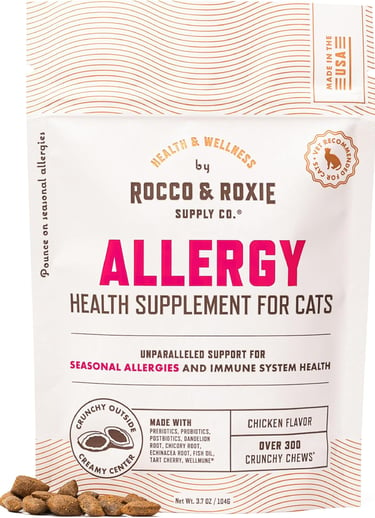Common Cat Allergies and How to Spot Them
Cat allergies are more common than many pet parents realize. Knowing the signs and what triggers them can help you keep your feline friend healthy, comfortable, and itch-free.
CAREHEALTH
Karlin T.
As someone who’s had cats in my life for as long as I can remember, I’ve learned that just like people, cats can have allergies too. But unlike people, they can’t exactly tell us when something is making them feel off. That’s where we come in.
Over the years, I’ve seen a few of my cats struggle with mystery symptoms scratching, sneezing, red skin, or even digestive issues. It wasn’t always easy to pinpoint the cause, but once I learned what to look for and how to work with my vet, it made a huge difference in their quality of life.
So if you’re wondering whether your cat might be dealing with allergies, here’s what I’ve learned based on experience and a lot of late-night research.
The Basics: What Are Cat Allergies?
An allergy is basically your cat’s immune system overreacting to something harmless. Instead of ignoring it, their body treats it like a threat, causing inflammation and irritation. Allergies in cats tend to fall into three major categories:
Food allergies
Environmental allergies (indoor or outdoor)
Flea allergies
Each one can trigger different symptoms, and sometimes they overlap, just to make things extra confusing.
How I First Noticed the Signs
One of my cats, Luna, started grooming herself constantly around her belly and back legs. At first, I thought it was just a quirky habit. But then the fur started thinning, and I realized she was chewing on her skin. She didn’t have fleas. Her appetite was fine. Something just wasn’t right.
After a few vet visits and a process of elimination, we found out she had developed an allergy to something in her food. A simple protein switch (from chicken to duck) made a world of difference.
It taught me how subtle allergy symptoms can be. Here are some of the most common ones I’ve noticed or learned to look for:
Signs Your Cat Might Have Allergies
Itchy skin: Constant scratching, licking, or biting—especially around the ears, belly, or paws.
Hair loss: Bald spots or thinning fur, often from overgrooming.
Red or irritated skin: You might see redness or scabs, particularly near the base of the tail or neck.
Sneezing or coughing: Especially if it happens frequently or in certain environments.
Watery eyes or nasal discharge: Clear, not cloudy or colored.
Ear infections or head shaking: These can be related to allergies, especially food or environmental ones.
Digestive issues: Vomiting, diarrhea, or frequent upset stomachs may be signs of a food sensitivity.
Lethargy or behavior changes: Allergies can make your cat uncomfortable and less active.
Of course, these symptoms can also point to other health problems, so it’s important to talk to your vet for a proper diagnosis.
Common Triggers I’ve Encountered
Fleas: One flea bite can cause intense itching for a cat with flea allergy dermatitis. Even indoor cats aren’t immune. Using a vet-approved flea prevention method regularly is key.
Food: The most common culprits tend to be proteins like chicken, beef, or fish, but grains or additives can also trigger reactions. It can take trial and error to figure out which ingredient is the issue.
Environmental allergens: These can include pollen, mold, dust mites, cleaning products, perfumes, smoke, or even certain fabrics. One of my cats used to sneeze like clockwork after I cleaned with a strong spray cleaner. Switching to unscented, pet-safe products made a big difference.
Getting a Diagnosis
In my experience, diagnosing allergies is rarely a quick fix. It takes patience and a process of elimination.
For food allergies, many vets recommend an elimination diet, where you feed your cat a novel protein (something they’ve never eaten before) and remove all other treats, flavored meds, and table scraps for at least 8 to 12 weeks. It’s tough, but it works.
Environmental allergies can sometimes be identified through blood or skin tests, but not always. In mild cases, changing your cat’s environment, like using an air purifier or switching to unscented litter, might be enough.
Flea allergies are usually easier to confirm, especially if symptoms improve with regular flea control.
What You Can Do at Home
If you suspect your cat has allergies, here are some things that helped me manage symptoms while figuring out the cause:
Switch to a limited-ingredient diet under vet supervision.
Vacuum and dust regularly to reduce indoor allergens.
Use unscented, dye-free cleaning products around the house.
Wash your cat’s bedding and toys frequently.
Keep up with flea prevention year-round.
Bathe your cat with vet-approved shampoo (if they tolerate it) to soothe itchy skin.
I also found that tracking symptoms in a simple notebook helped me spot patterns I might have missed otherwise, like seasonal flare-ups or reactions to a new brand of litter.
Final Meow
Dealing with cat allergies can be frustrating. It’s not always easy to pinpoint the cause, and it takes time to find what works. But once you do, the change in your cat is incredible, happier, healthier, and no longer scratching or hiding in discomfort.
As cat parents, we get to know our feline friends better than anyone else. Trust your instincts. If something seems off, don’t be afraid to ask your vet questions, test a few changes, and advocate for your pet.
Because in the end, their comfort is worth it, and watching them thrive is the best reward.
Kitty Catz
Follow Kitty Catz on social media for purrfect updates and blog highlights!
© 2025-2030. All rights reserved.



